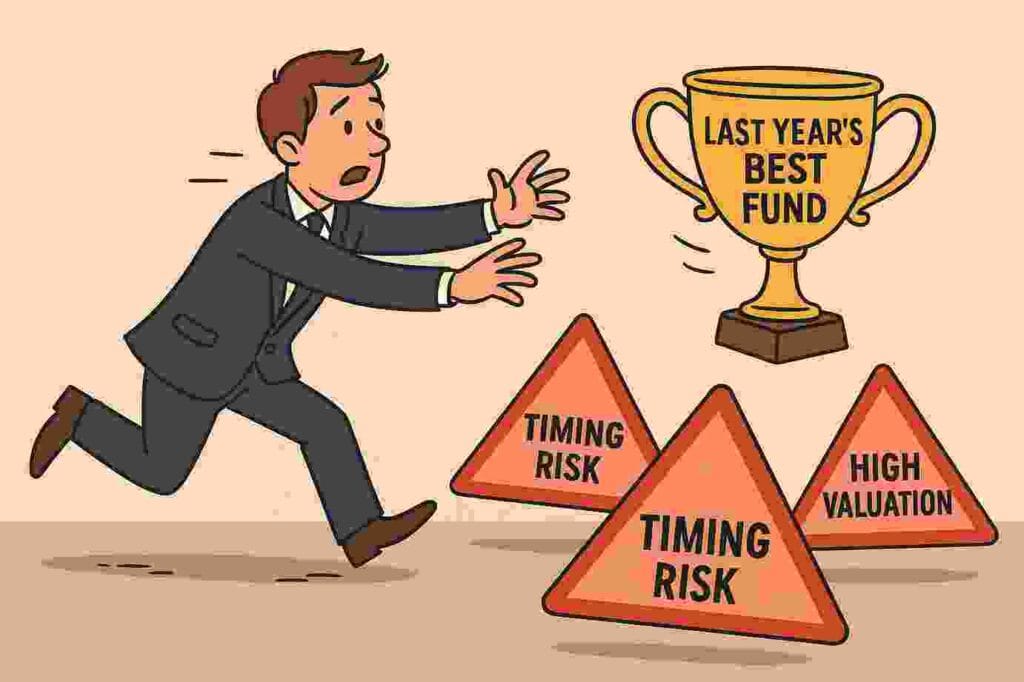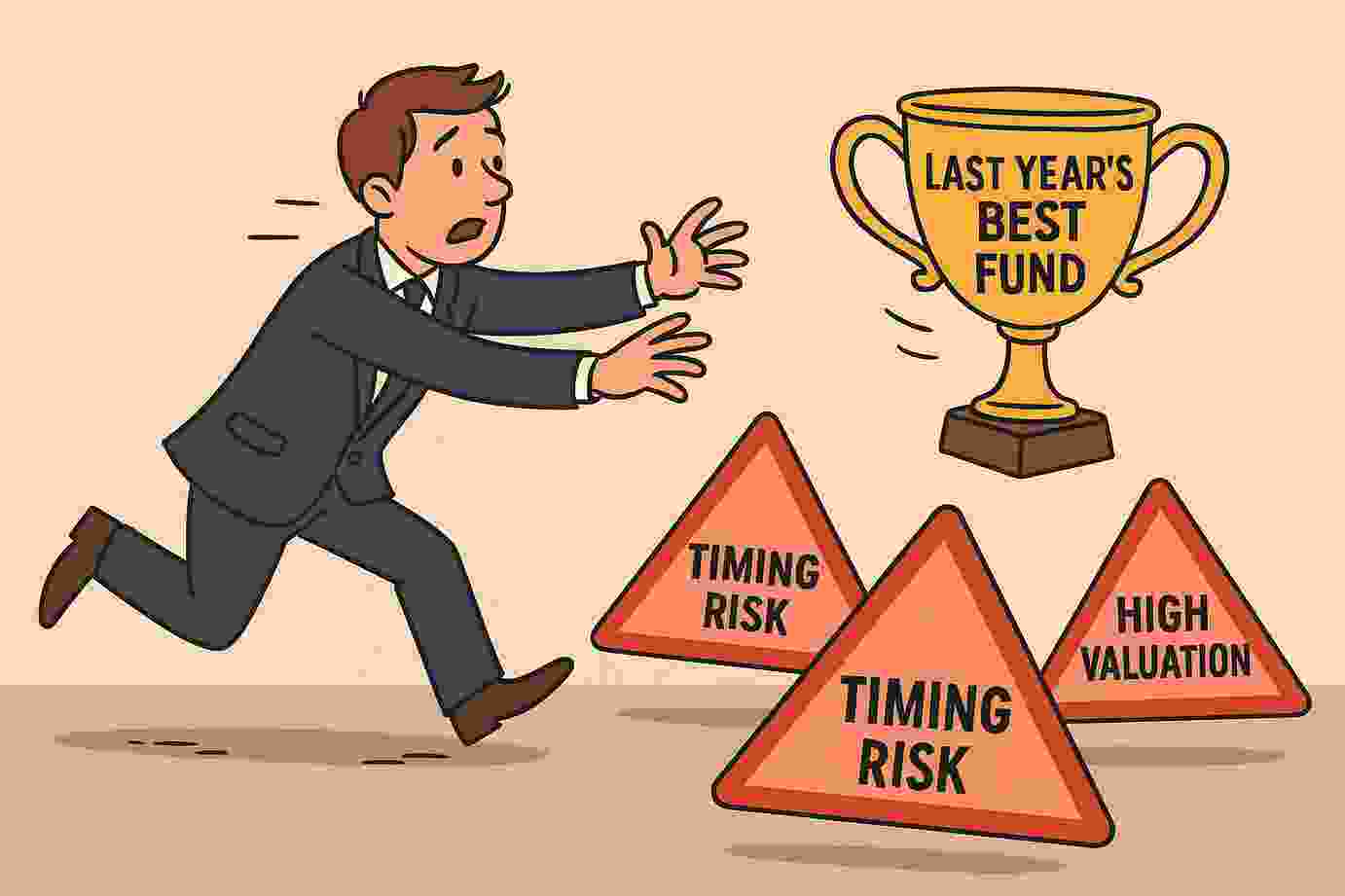Discover the 7 critical risks of chasing high-performing funds and why past success doesn’t guarantee future gains. Learn smarter investment strategies to protect your wealth. #risks of chasing high-performing funds, #why top funds fail, #mutual fund risks, #investment mistakes, #past fund performance, #smart fund selection, #high-performing mutual funds

Introduction: The Allure and Danger of High-Performing Funds
The prospect of spectacular returns frequently attracts investors to high-performing mutual funds. It may appear that a fund that was at the top of the charts the previous year is a sure bet, but is it? The risks of chasing high-performing funds are frequently disregarded, which can result in expensive errors. Historical investing data shows that 68% of the top-performing funds from the previous year did not continue to rank in 2024. This article outlines the seven risks of chasing high-performing funds and provides helpful advice for making more informed investment decisions. You may safeguard your portfolio and attain long-term financial success by being aware of these pitfalls.
Risks of Chasing High-Performing Funds
Past Performance Doesn’t Predict Future Success
The most common investing misunderstanding is that a fund’s historical performance ensures future outcomes. When you consider how quickly market conditions may change, risks of chasing high-performing funds become clear. Because of changes in interest rates, recessions, or industry volatility, a fund that did well in 2023 can have trouble in 2025. For instance, when markets corrected in 2022, tech-heavy funds that were dominant in 2020 frequently underperformed.
Why It’s Risky: Past performance is a reflection of certain circumstances rather than the intrinsic strength of a fund. The dangers of chasing high-performing funds, like market timing errors, are disregarded when pursuing these products.
Smarter Choice: Pay attention to funds that have performed well for five to ten years, not simply one exceptional year. See Morningstar’s mutual fund evaluation guide for advice on determining long-term stability.
Higher Fees Can Erode Your Returns
Due to fund managers taking advantage of their performance, high-performing funds frequently have higher expense ratios. The dangers of pursuing high-performing funds include the possibility of paying premium fees for gains that never come. As per Vanguard’s analysis, the average expense ratio for actively managed funds in 2024 was 0.67%, while index funds had an expense ratio of 0.08%.
Why It’s Risky: The reason it’s risky is that high fees reduce your earnings, particularly if the fund performs poorly. A 1% increase in fee can knock thousands of dollars off your portfolio over a ten-year period.
Smarter Choice: It’s wiser to choose inexpensive index funds or exchange-traded funds (ETFs) with proven performance histories. Comparing expense ratios can be done with tools such as Fidelity’s fund screener.
Market Timing Traps Lead to Losses
Chasing high-performing funds frequently entails attempting to time the market, which is a dangerous tactic. When investors purchase at a peak and then see returns fall, the risks of chasing high-performing funds are increased. For example, when oil prices stabilised in 2023, investors that jumped into energy funds during the 2022 oil boom lost money.
Why It’s Risky: Even for experts, market timing is infamously challenging. The hazards of chasing high-performing funds are increased when you purchase them at their top because you run the risk of buying high and selling low.
Smarter Choice: To spread your investment over time and lessen your exposure to market volatility, use a dollar-cost averaging technique. Visit Investopedia’s guide to dollar-cost averaging for additional information.
Overconcentration in Volatile Sectors
Hot, sometimes turbulent industries like biotech and technology are frequently the focus of high-performing funds. Chasing high-performing funds carries dangers, such as overexposure to industries that could collapse when market trends change. Many investors poured money into crypto-focused funds in 2021, only to suffer significant losses during the crypto winter of 2022.
Why it’s risky: The dangers of pursuing high-performing funds are increased by sector-specific funds’ lack of diversification. Gains might be wiped out by a single market occurrence.
Smarter Choice: The wiser course of action is to create a diversified portfolio that spans several industries and asset types. For advice, look into Schwab’s diversification tactics.
Manager Risk: The Human Factor
The skill of a fund’s manager frequently determines its success, yet managers are subject to change. Chasing high-performing funds carries dangers, such as depending on a star manager who might depart and take their approach with them. Following the departure of important managers, the performance of a number of leading funds declined in 2023.
Why It’s Risky: The strategy of the fund may change under a new manager, which would impact its performance and risk profile. Investors may be unprepared for this hidden danger associated with chasing high-performing funds.
Smarter Choice: A wiser course of action would be to look at the tenure and management team of the fund. To keep tabs on manager changes, use Bloomberg’s fund analysis tools.
Regression to the Mean
Over time, high-performing funds frequently experience regression to the mean, which is the return to average performance. It is obvious that chasing high-performing funds carries risks: what rises frequently falls. As to S&P Global’s SPIVA report, research indicates that 80% of funds in the top quartile drop to the second or third quartile in just five years.
Why It’s Risky: It is riskier to chase high-performing funds if you expect sustained outperformance, which ignores statistical tendencies.
Smarter Choice: It’s wiser to prioritise funds that have consistently performed above average rather than chasing anomalies. S&P Global’s persistence scorecard contains information about fund consistency.
Emotional Investing Clouds Judgment
FOMO (fear of missing out) frequently drives emotional decisions that lead to chasing high-performing funds. Making snap decisions without conducting adequate research is one of the risks of chasing high-performing funds. Emotional investing might result in locking in losses by purchasing at inflated prices and selling during downturns.
Why It’s Risky: Logic is subordinated to emotions, which results in bad financial choices. When investors panic during market declines, the hazards of pursuing high-performing funds are exacerbated.
Smarter Choice: Create a goal-oriented, disciplined investment plan. Examine Bogleheads’ investment philosophies for a logical method of accumulating wealth.
Conclusion: Invest Smarter, Not Harder
The risks of chasing high-performing funds are numerous, from unpredictable market shifts to high fees and emotional traps. Even while the top fund from the previous year has a lot of appeal, history demonstrates that past performance is not a reliable indicator of future success. You can reduce the risks of chasing high-performing funds and create a robust portfolio by emphasising diversity, inexpensive funds, and disciplined techniques. Instead of pursuing short-lived fame, take charge of your financial destiny by making thoughtful, well-informed decisions.
FAQs: Risks of Chasing High-Performing Funds
Q1: Why don’t high-performing funds stay on top?
High-performing funds frequently depend on particular industries or market circumstances that might not last. The dangers of pursuing high-performing funds are increased by regression to the mean and shifting economic conditions.
Q2: How can I avoid the risks of chasing high-performing funds?
Diversify your holdings, concentrate on inexpensive funds, and give steady performance precedence over ephemeral profits. Morningstar and other research tools can be useful.
Q3: Are high-performing mutual funds riskier than index funds?
The hazards of chasing high-performing funds are decreased by index funds, which frequently have cheaper costs and greater market exposure. But first, evaluate your objectives and level of risk tolerance.
Q4: How can I tell if the fees charged by a fund are excessive?
Examine the fund’s expense ratio in relation to the industry average (e.g., actively managed funds’ 0.67% against index funds’ 0.08%). Use the charge comparison tool offered by Vanguard.
Q5: Can I still make safe investments in high-performing funds?
Sure, but proceed with caution. To reduce the risks associated with chasing high-performing funds, investigate the fund’s strategy, manager tenure, and sector exposure.
Disclaimer: Risks of Chasing High-Performing Funds
The possible loss of money is one of the risks associated with investing. This article’s on Risks of Chasing High-Performing Funds is intended solely for educational purposes and should not be interpreted as financial advice. A professional financial advisor should always be consulted before making any investing decisions. The risks of chasing high-performing funds can differ depending on specific conditions, and past performance is not a reliable predictor of future outcomes.
Also Read:

